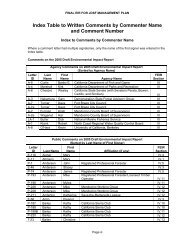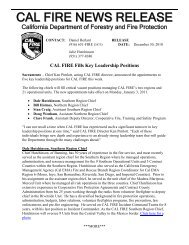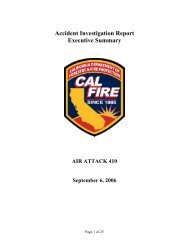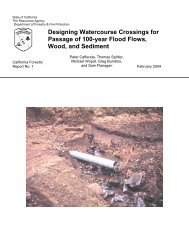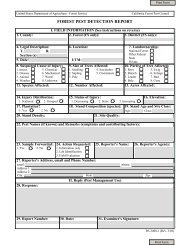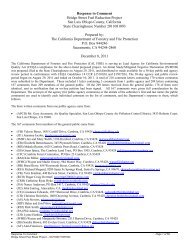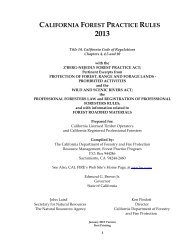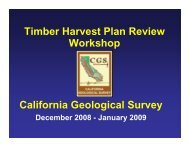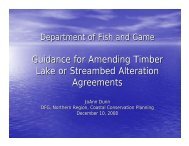Boggs Mountain Demonstration State Forest Draft ... - Cal Fire
Boggs Mountain Demonstration State Forest Draft ... - Cal Fire
Boggs Mountain Demonstration State Forest Draft ... - Cal Fire
Create successful ePaper yourself
Turn your PDF publications into a flip-book with our unique Google optimized e-Paper software.
<strong>Boggs</strong> <strong>Mountain</strong> <strong>Demonstration</strong> <strong>State</strong> <strong>Forest</strong> <strong>Draft</strong> Management Plan, June 2008<br />
during the winter period. The waterbar should be extended to the cutbank to intercept all ditch<br />
flow and extend beyond the shoulder of the road. A berm must block and prevent ditch flow from<br />
continuing down the road during flood flows. The excavated waterbar should be skewed 30<br />
degrees to the ditch-line with the excavated material bermed on the downhill grade of the road.<br />
Water should always be discharged onto the downhill side on a stable slope protected by rip-rap<br />
or vegetation. The cross ditch depth and width must allow vehicle cross-over without destroying<br />
the function of the drain.<br />
4. Critical Dip (CD)<br />
Critical dips are broad swales excavated into the bed of the maintained road in order to eliminate<br />
the potential for stream diversion if the culvert plugs during a storm or flood. At stream crossings<br />
with a high diversion potential, floodwaters back up behind a plugged culvert, flow onto the road<br />
surface (or into the ditch) and flow down the road. In a crossing with no diversion potential,<br />
floodwaters emerging onto the road surface travel across the road prism and back into the<br />
channel on the lower side of the crossing potentially washing out the fill.<br />
Critical dips may be excavated over the top of the crossing, provided the culvert is deeper than<br />
the proposed excavation. If the culvert is located shallow in the crossing fill, the excavation for the<br />
critical dip may be made immediately down-road from the crossing site. The excavation work can<br />
typically be performed with a crawler tractor in 1 to 1.5 hours.<br />
5. Rolling Dip (RD)<br />
Rolling Dips are simply breaks in the grade of a road. They are sloped either into the ditch or to<br />
the outside of the road edge to drain and disperse road surface runoff. Rolling dips are installed in<br />
the roadbed as needed to drain the road surface and prevent rilling and surface erosion. They are<br />
most frequently used on outsloped roads.<br />
Excavation for a rolling dip typically begins 50 to 100 feet up-road from where the axis of the dip<br />
is planned. Material is progressively excavated from the roadbed, slightly steepening the grade<br />
until the axis is reached. This is the deepest part of the excavation, with the overall depth being<br />
determined by the slope of the road. The steeper the road, the deeper the dip will have to be in<br />
order to reverse grade. To effectively direct runoff to the side of the road, the axis of a rolling dip<br />
should be angled about 30 degrees to the road alignment. On the down-road side of the rolling<br />
dip axis, the road bed slope should actually rise slightly to ensure that runoff cannot continue<br />
down the road surface. This is called a “grade change”.<br />
The rise in grade is carried for about 10 to 20 feet before the road surface begins to fall again at<br />
its original slope. This transition from axis bottom, through rising grade, to original falling grade is<br />
achieved in a road distance of 15 to 30 feet. The rolling dip should be broad and shallow enough<br />
to permit low-boys, log trucks and other equipment to pass without slowing traffic excessively or<br />
causing them to scrape bottom.<br />
59



